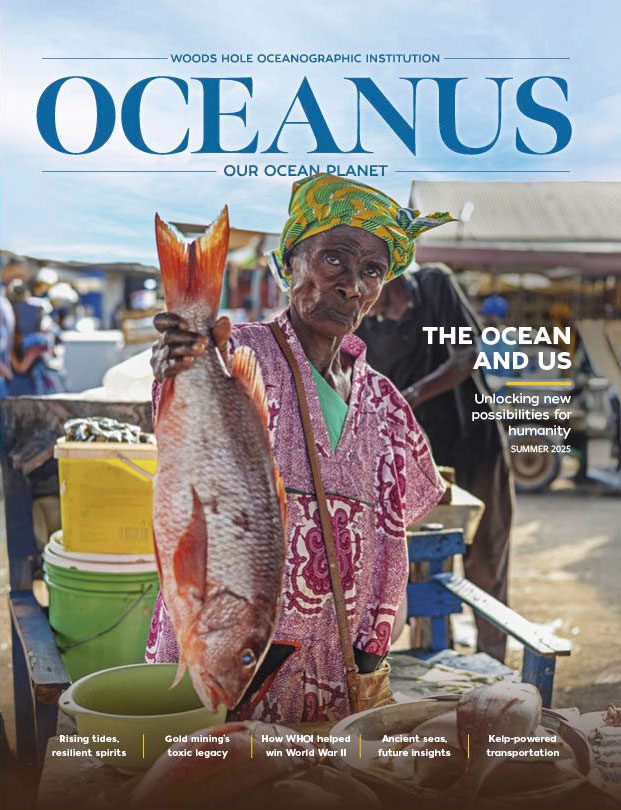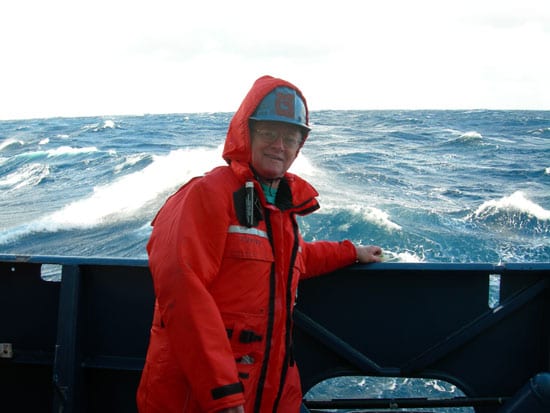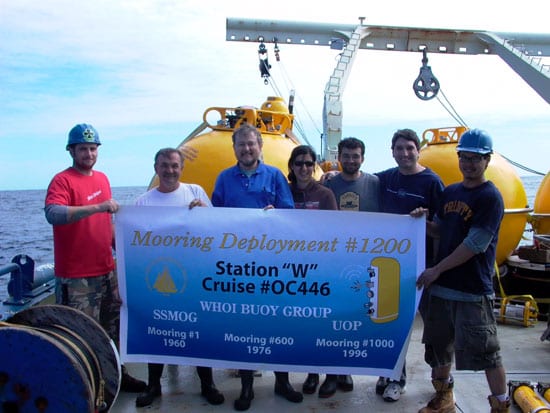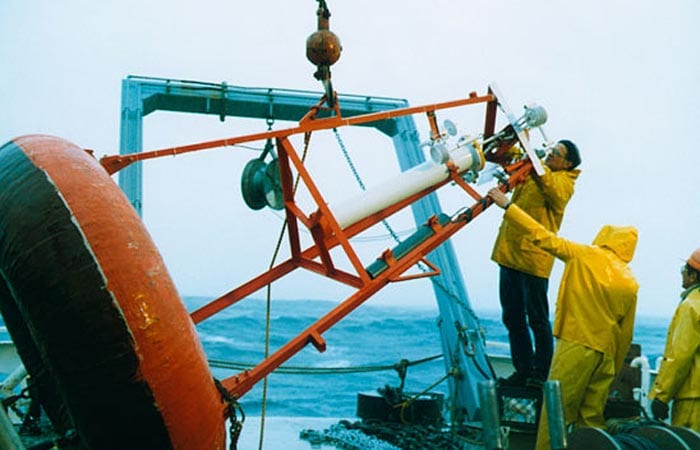
Building Them Tough, Bringing Them Back
WHOI's pioneering Buoy Group celebrates its 50th anniversary
Fifty years ago, on Dec. 11, 1960, a group of scientists, engineers, and technicians from Woods Hole Oceanographic Institution set a doughnut-shaped buoy into the waters off Bermuda. Anchored by a line to a pair of old train wheels, the buoy remained in place for 79 days. No record was made of what scientific instruments, if any, were attached to the mooring line; but this modest endeavor, WHOI buoy station #001, marked the beginning of the WHOI Buoy Group—and a new era in physical oceanography.
In 1959, the renowned oceanographer John Swallow had set out six instruments he invented to float in the depths and measure currents as they were swept along in the ocean’s interior. Swallow put all six in the water near each other, and waited.
“He assumed he would have no problem tracking them because they would all go the same way,” said Scott Worrilow, who joined the Buoy Group in 1978. “Well, the floats went this way, that way, that way, and that way, “ Worrilow said, pointing his arms in every direction. “It was an eye-opener, for him and everybody, who said, ‘God, the ocean is much more complex than we thought.’ ”
Under the direction of physical oceanographer Bill Richardson, the newly formed Buoy Group set out to develop ways to discover what was happening far beneath the ocean surface and to explore the complex interactions between sea and air. Their tools of choice were anchored mooring lines, which carried current meters, thermometers, pressure gauges, and other instruments. Surface buoys kept the lines upright in the water, marked the lines’ locations, and carried meteorological instruments such as rain and wind gauges.
Murphy’s Law and the marine environment
Doing world-class oceanography requires more than world-class scientists. It also requires world-class technicians and engineers who can design instruments that will survive in the deep ocean, figure out how to deploy those instruments, and recover them months or years later. That’s what the WHOI Buoy Group supplied.
“We were the facilitators,” Worrilow said. “The scientists came up with the ideas, and we made it happen.” But not that easily. The WHOI Buoy Group’s “remarkable effort, which lasted over a decade, was a fundamentally experimental war against Murphy’s Law,” Russ Davis, an oceanographer at Scripps Institution of Oceanography, wrote in 2006.
Buoyed moorings might sound like little more than an oversized fishing line—a sinker at the bottom, a few instruments hanging from the line, and a bobber at the top. What could be simpler?
As it turned out, nothing about buoys and moorings was simple. For one thing, the sheer scale of a deep-sea mooring is hard to comprehend: The Buoy Group deploys lines more than three miles long. Think about that the next time your 30-foot fishing line gets tangled during a cast.
Once in the water, the lines and instruments are besieged by salt, freezing cold, pressure up to 10,000 pounds per square inch, powerful currents, and surging waves. Even getting a mooring back out of the water is a tremendous challenge. The Buoy Group quickly learned they couldn’t just reel in a mooring by pulling on the top of the line; with the anchor still attached, the line usually broke.
They experimented with several ways to get the line to let go of the anchor. One method used a weak link between the anchor and the line. It was supposed to break when the recovery team pulled on the upper end of the mooring, allowing the team to recover the rigging and instruments. Unfortunately, other parts of the line often broke instead, causing many of the instruments and data to be lost.
Another method they tried was a corrosible link. The idea was that corrosion, normally an enemy to moorings, would cause the link to break, releasing the mooring. That didn’t work well because the link didn’t always corrode at the same rate, and the recovery team couldn’t predict when the release would occur.
As George Tupper, a 43-year veteran of the Group, put it, “The ocean is a tremendously hazardous place to put anything that you want to last for a while and do anything useful. The ocean wins most of the time.”
A strategic retreat
At first, still learning how everything could go wrong in this punishing frontier of ocean exploration, the Buoy Group barely held its own against the ocean. In 1967, with the group losing almost as many moorings as it recovered, then-group leader Bob Heinmiller called an “all stop,” decreeing that WHOI researchers would not deploy another mooring until they figured out what wasn’t working, and fixed it.
They succeeded. Within a few years, deployment times increased from two months to two years, and the mooring recovery rate jumped to 95 percent.
One of their biggest breakthroughs was gaining the ability to tell a mooring when to let go of its anchor and come to the surface. That was achieved with a device that responds to a coded acoustic signal sent by researchers on a ship. The signal releases the chain connecting it to the anchor. Acoustic releases had been tried before, but they had a high failure rate. They either released prematurely, when no one was nearby to retrieve the mooring, or they didn’t release at all. The development by AMF Corporation (best known as a maker of bowling equipment) of a reliable acoustic release enabled the Buoy Group to recover moorings at will.
The Group also began attaching floats near the bottom of the mooring line, just above the acoustic release. If any part of the rigging broke, the team could trigger the release and the floats would bring what was left of the mooring to the surface, where the instruments and their recorded data could be rescued.
Recovering broken moorings allowed the engineers to examine what failed and try to fix it in future moorings. It also greatly enhanced the Group’s ability to create new instruments for measuring current and other ocean properties.
“There was a lot more incentive to make our instruments work better, because you knew you were going to see them again,” recalled Tupper, who began his career at WHOI as a current meter technician. He and other members of the Buoy Group went on to develop instruments that revolutionized the study of the oceans—some of which are still in use today.
“For many years the WHOI Buoy Group was the leader in both technical and scientific areas,” wrote Davis. “Other groups were formed around the country using methods and equipment developed by the Buoy Group and employing personnel trained there. At the same time, Buoy Group work motivated an interest in observations and technical developments that made new measurements possible. It was an exciting center of observational oceanography.”
WHOI-led advances in mooring technology made possible the multi-institution, multinational mooring projects of the 1970s and 1980s that revealed major current systems, such as the ocean conveyor in the North Atlantic, and the air-sea interactions in the central Pacific that produce El Niño and La Niña climate events.
Still innovating after all these years
In 1989 the Buoy Group disbanded into more specialized subunits. But the innovation has never ceased, with WHOI technicians continuing to deploy moorings around the world and to devise new moorings to work in ice-covered polar waters, listen for endangered whales in shipping lanes, and serve as platforms for launching free-roving underwater gliders.
Other forms of technology, such as satellite-mounted instruments, are sometimes touted as the new wave in ocean observation. But Worrilow doubted satellites would ever provide the penetration needed for deep-water-ocean measurements. “You’re going to have to have some on-site instrument that you’re going to have to put in the water.”
And get it to work well. And make it last. And get it back. At this writing, Worrilow, who now heads the WHOI Sub-Surface Mooring Operations Group, was deploying WHOI moorings Nos. 1239 and 1240 in the waters near Hawai’i.
Oceanus thanks Scott Worrilow, George Tupper, and Jerry Dean from the Buoy Group and WHOI physical oceanographer John Toole for alerting us to this anniversary and for sharing their knowledge of Buoy Group history; and Dave Sherman and Colleen Hurter at the WHOI Archives for providing oral histories and searching for photographs of the Buoy Group’s early years.
Slideshow
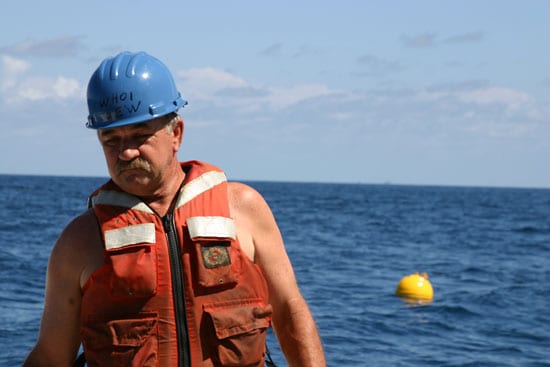
Slideshow
 Scott Worrilow started working with the WHOI Buoy Group in 1978 and is now head of the Sub-Surface Mooring Operations Group. He has spent a lot of time at sea deploying and recovering moorings. And that's where he was on the 50th anniversay of the WHOI Buoy Group's first mooring. His team recently deployed moorings Nos. 1239 and 1240 in the waters near Hawai'i. (Woods Hole Oceanographic Institution)
Scott Worrilow started working with the WHOI Buoy Group in 1978 and is now head of the Sub-Surface Mooring Operations Group. He has spent a lot of time at sea deploying and recovering moorings. And that's where he was on the 50th anniversay of the WHOI Buoy Group's first mooring. His team recently deployed moorings Nos. 1239 and 1240 in the waters near Hawai'i. (Woods Hole Oceanographic Institution)- Repairs to instruments go on night or day, good weather or bad. Here, oceanographer Jerry Dean works on the atmospheric instruments atop a toroid (doughnut-shaped) surface buoy so the buoy and its mooring can be deployed again. (Photo courtesy of Jerry Dean)
- George Tupper, who worked on current meters when he first came to work with the Buoy Group in 1968, has participated in about 40 research cruises since his official retirement in 2001. (Photo by Terry Joyce)
- The WHOI Buoy Group split into sub-groups 20 years ago, but the mooring count continues. In 2006, members of the Upper Ocean Processes Group and Sub-Surface Mooring Operations Group deployed mooring No. 1200 as part of the Line W array. From left, Brian Hogue, Scott Worrilow, physical oceanographer John Toole, MIT/WHOI graduate student Beatriz Pena-Molino, Dan Torres, Dave Wellwood, Daniel Bogorff. (Photo by Daniel Montlucon)
